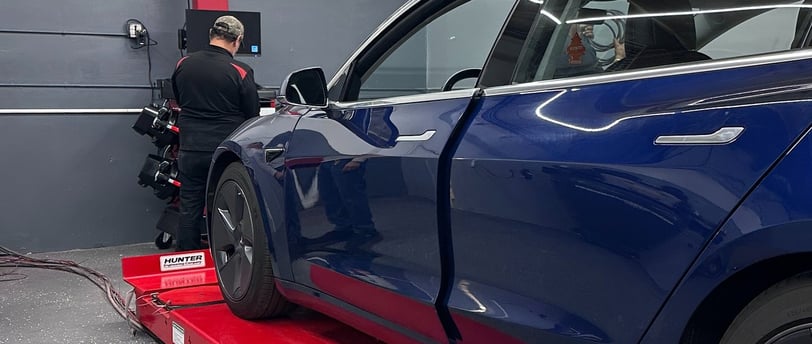When a Wheel Alignment Won’t Help — And What to Fix First
A wheel alignment won’t fix everything. Learn when it’s the wrong time to get one—and what issues to address first for the best results
WHEEL ALIGNMENT
George D.
4/14/20252 min read


Wheel alignment is important for proper handling, tire wear and overall vehicle performance. That said, there are instances when a wheel alignment is useless or a total waste of your time and money. If you get to a point where you’re ready to schedule, ensure your car is actually ready for the procedure." Here are some of the common scenarios when you leave wheel alignment:
Worn or Damaged Suspension Parts
If your vehicle has worn-out ball joints, control arms, bushings, tie rods, or any other suspension components, an alignment won’t last. The alignment machine might set the correct angles, but once the car is back on the road, those settings will shift due to looseness or play in the suspension. Always replace damaged or worn parts before attempting a wheel alignment.
Unevenly Worn or Damaged Tires
Disavow well-worn, cupped tires, as they can provide false readings during alignment and may pull or vibrate even after repair. And if the tread wear is uneven, or the tires have bulges or flat spots, it’s best to replace the tires first — otherwise, the alignment will be ineffective or lead to poor handling.3. After an
Accident With Unrepaired Damage
IIn the event that your car has recently been in a collision and still has frame or structural damage, wheel alignment is premature. If the chassis isn’t straight, however, it must first be inspected and spot-drawn, or corrected; otherwise, the car will be aligned and the readings won’t be correct and won’t hold.
Steering Problems Not Yet Diagnosed
Mechanical problems — not necessarily misalignment — can cause issues such as a loose or wandering steering wheel, or pulling to one side, or inconsistent responsiveness. Assuming you have internal damage of the steering system, worn racks, or leaking power steering components, alignment will not help you. Align then fix root cause
Immediately After Installing New Suspension Components
New springs, shocks, struts and some other suspension parts can require some time to settle after being installed. The ride height may be a bit high after installing the coils, causing alignment angles to be incorrect initially. Typically, the park is driven for a few days or 100–200 miles, and the final position is returned for adjustment once everything has settled.
Unresolved Vibration or Pulling Issues
But if your car pulls left or right only sometimes, or if you feel vibrations at certain speeds, the culprit could be tire imbalance, bent wheels or even a damaged CV axle. Without knowing the true cause of the problem, performing an alignment may not be of any assistance. Always address other mechanical problems first before adjusting alignment.
Extreme Weather Conditions
In cold weather, snow buildup, ice, and road slush can temporarily affect how your car tracks or steers. Some drivers think they need an alignment because their car feels "off" — when in reality, it’s just slippery or uneven road conditions. Wait until the roads are clear and dry to assess whether your alignment is truly off.
✅ When Is Your Car Ready for an Alignment?
Make sure:
Suspension - All components in good condition
Ensure that the tires are well maintained and inflated
Any damage caused by accidents has been repaired to a professional standard
Steering symptoms are not out of the ordinary
Suspension upgrades or repairs have had time to "bed in"
This way, you’ll avoid unnecessary expenses and ensure accurate results with a long-lasting impact. Not sure? Come in for a complimentary alignment check — no pressure, no obligation.
Wheel alignment services by car type we provide:
Passenger vehicles - suitable for most sedans, coupes, compact cars, or all-wheel-drive vehicles as their hybrid versions
SUVs - compact, mid-size, full-size SUVs, crossovers, or off-road vehicles, as their hybrid version
Trucks and Minivans - trucks, heavy-duty trucks, pickups, commercial vehicles, or minivans
Lowered cars - Lowered cars
Classic cars - suitable for most Classic cars since 1950 your text here...
Electric cars - all types of electric cars including Tesla and Rivian
George's Alignment & Brake Service
Contacts:
tel:+1 818 855 6545
Operation hours:
Mon-Sat: 10am - 5pm
Service areas:
Calabasas Canoga Park Chatsworth Encino Granada Hills Hidden Hills Lake Balboa Northridge
Porter Ranch Reseda Sherwood Forest Tarzana Van Nuys West Hills Winnetka Woodland Hills
Location #2
9345 Melvin Ave Unit 6,
Northridge, CA 91324
